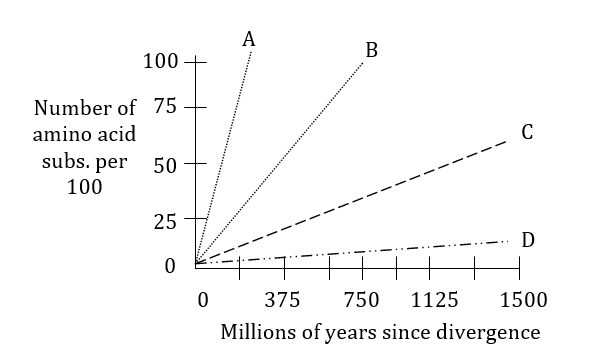Essay
The rate of change is not identical for all genes.The following graph shows the rate of change of four hypothetical human proteins (A-D).Use this graph to answer the following questions.

a)Which of the proteins is changing at the fastest rate?
b)Which protein is most conserved?
c)Which evolutionary force (drift,selection,or migration)plays the biggest role in causing the observed difference in the rate of change between proteins A-D?
d)If you do Southern hybridization to determine if the genes encoding each of these human proteins (A-D)also exist in rice,which would give the strongest hybridization signal? Justify your answer.
e)If you were going to use one of the proteins to build a phylogenetic tree of various mammalian species (which diverged during the last 50 million years),which protein sequence would be most useful? Justify your answer.
f)If you were going to use one of the proteins to build a phylogenetic tree of various plant species (which diverged during the past 500 million years),which protein sequence would be most useful? Justify your answer.
g)If you were going to use one of the proteins to build a phylogenetic tree of a mixture of plant and animal species (which diverged 1200 million years ago),which protein sequence would be most useful? Justify your answer.
Correct Answer:

Verified
a)A
b)D
c)Selection.There is a lot of se...View Answer
Unlock this answer now
Get Access to more Verified Answers free of charge
Correct Answer:
Verified
b)D
c)Selection.There is a lot of se...
View Answer
Unlock this answer now
Get Access to more Verified Answers free of charge
Q32: Following a gene duplication event,the additional copy
Q33: Suppose that a population composed of 100
Q34: Which of the following are requirements for
Q35: When considering the rate of nucleotide divergence
Q36: Most genetic variation for many human loci
Q38: Darwin's theory of evolution was developed around
Q39: An orchid breeder is interested in increasing
Q40: Assume that the following amino acid sequences
Q41: In southwestern Arizona,the melanocortin 1 receptor mutation-bearing
Q42: Tony Allison examined the allele frequency of